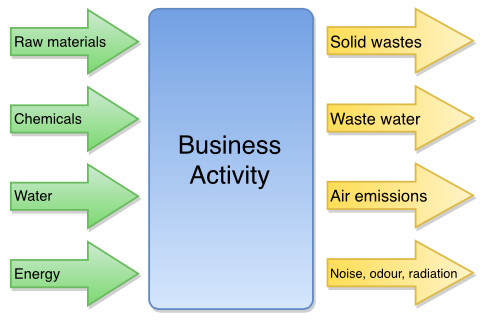
First let's get a quick clarification about “Aspects” and “Impacts”.
“Aspects” are the things you do that interact with the environment. This includes energy and materials that go in to your process, and various wastes that come out.
“Impacts” are how those inputs and outputs change the environment.
e.g., Aspect: use of solvent cleaners —> Impact: Air pollution
Aspect: cardboard packing boxes —> Impact: land fill, use of natural resources
The aim of the exercise is to identify any significant aspects that do (or might) have a significant impact on the environment, and to develop a plan for reducing them.
Identify Aspects
The diagram above shows different categories of aspects you’ll need to think about.
A small business may be able to analyse the inputs and outputs of the business as a whole, but it is often better to break the analysis down into smaller units – e.g. departments, work areas, or individual processes. The level of detail depends on the complexity of your operations. You’ll want to find the ‘sweet spot’ that provides enough detail to capture all your inputs and outputs, without going so deep that you repeat yourself.
Start by listing all of the inputs and outputs for each process, covering all of the categories above. Any existing process documentation is a good basis. Also consider how start-up, shutdown and emergency conditions may change the environmental aspects of a process compared to normal operations. Don’t forget to analyse off-site activities like installation, as well as onsite activities like production. Energy use in the transport of materials and people should not be forgotten.
Determine which are Significant Aspects
The next step is to evaluate all these aspects to determine which (if any) are significant. The ISO 14001 environmental management standard says that you can rule out anything you have no control over. Also, there’s nothing in the standard to tell you what, or how much, is “significant” – you must decide. Be sure to keep records of your analysis to justify your decision.
Here are some criteria to consider:
- are there regulations that apply?
- what quantities are used or produced?
- has the business set goals or targets for any of these aspects?
- how are the aspects viewed by external stakeholders? – e.g the community in which you operate.
Set Objectives
Every significant environmental aspect needs to be addressed with an action plan, e.g.,
- put in place ongoing controls
- implement improvements
- conduct further investigation to gather more information (before deciding what to do)
When planning how to address each significant aspect, think about:
- prioritising aspects with the highest risk of causing damage to the environment
- what is the potential for improvement?
- how feasible is it (technically and financially) to make a change?
You can influence aspects by changes in your core activities, staff behaviour, purchasing decisions, choices of vehicles and travel arrangements.
Whatever the plan is, you need to set a date for completion and assign somebody to be responsible for making it happen.
Review and Revise
Since nothing ever stays the same, you need to periodically review your analysis and check for any internal or external changes that may affect your environmental aspects and their impacts.
You should also regularly review any control measures you put in place to make sure they are effective.